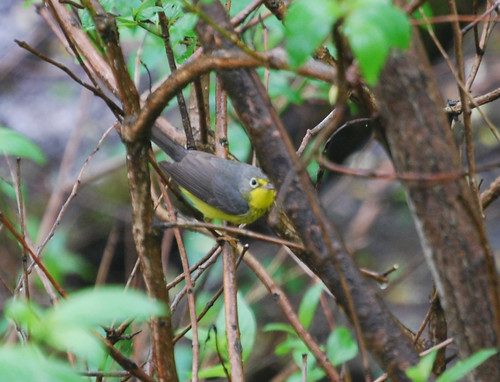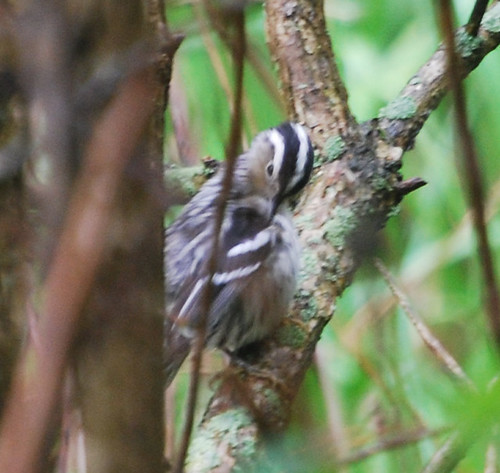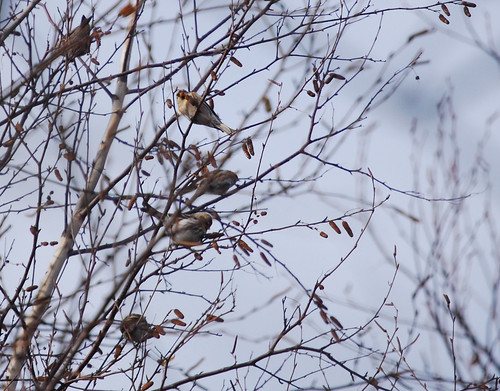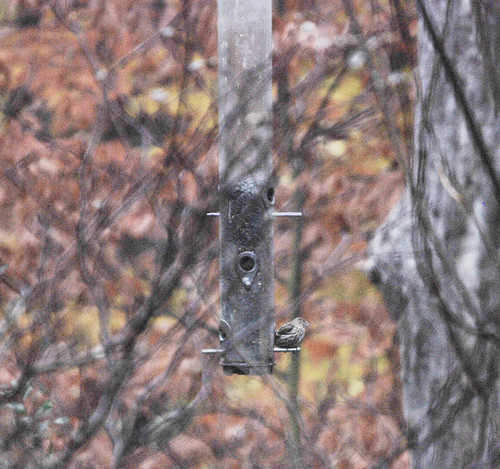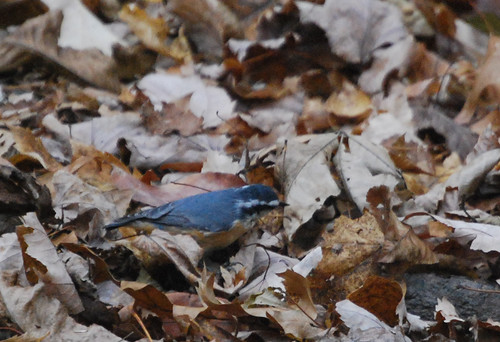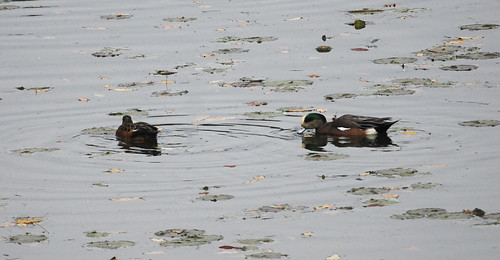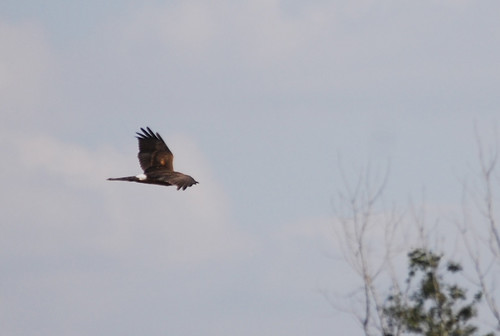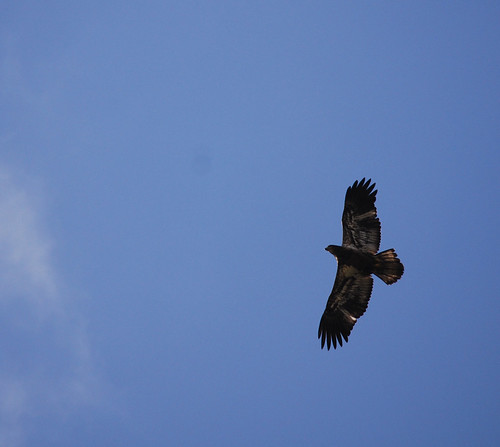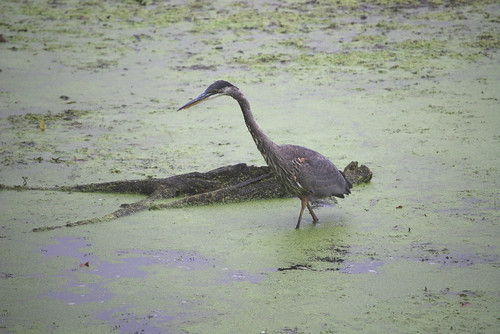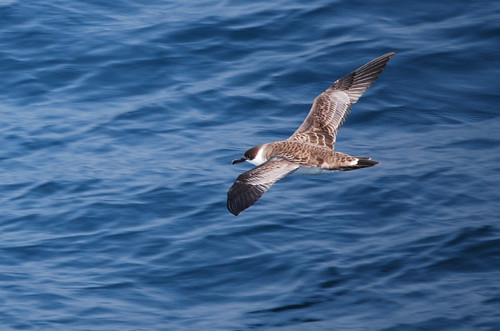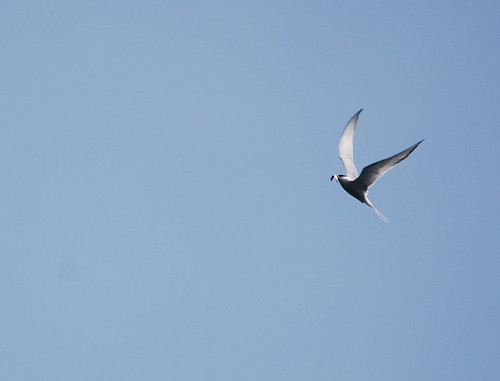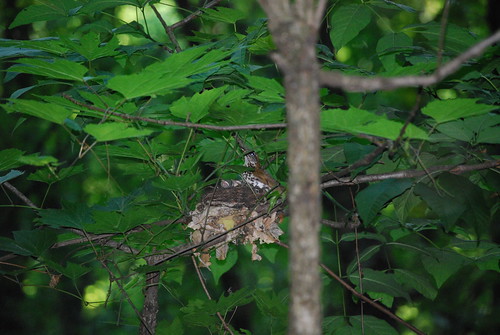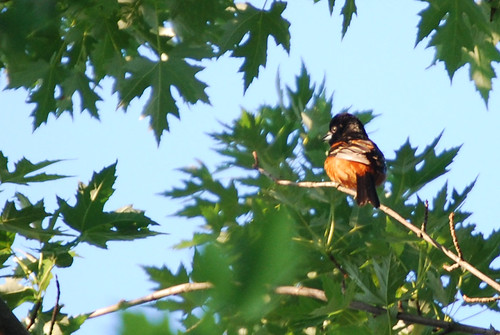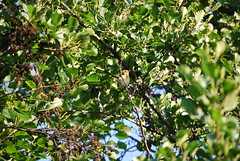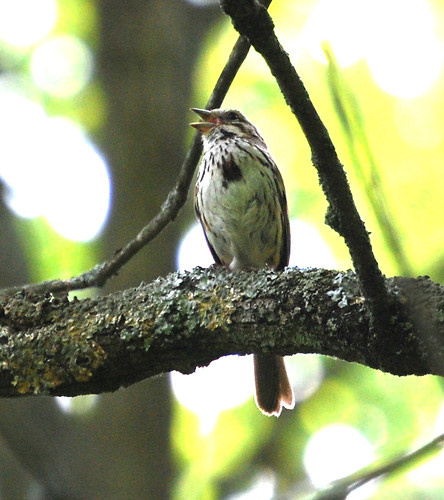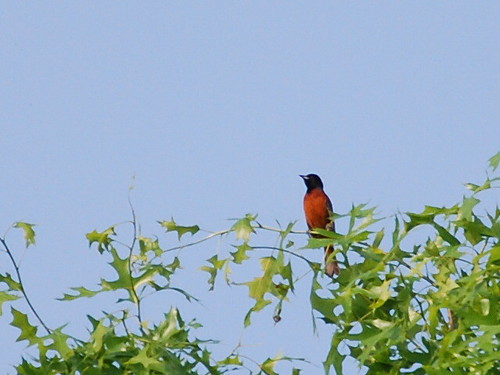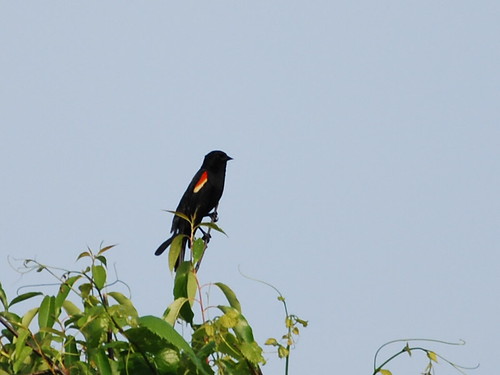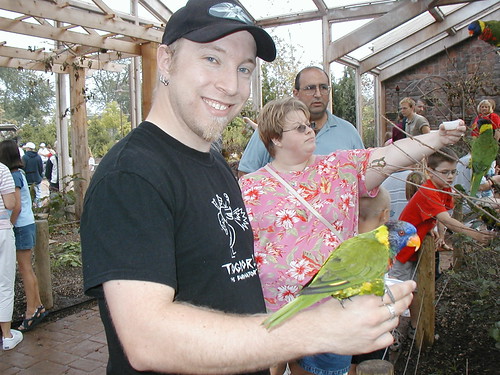Thursday, December 20, 2007
Heading home for the Holidays
View Larger Map
One of the good things about living way up north are the way up north birds. Last time I was up for the holidays, I picked up Spotted Towhee and Pine Grosbeak for my life list. This time around, the target bird is a really cool one: Gyrfalcon!
A Gyrfalcon seems to be settling in for the winter in the lower harbor in Marquette, Michigan, a measly hour and a half drive from Hancock. It's also where the wife and I are going on the 28th to visit friends, so I believe that a stop to see a Gyrfalcon will be tolerated.
I was also going to try and see Black-backed Woodpecker, but the burn area where they've been reported is now only accessible through snowshoes or skis, so that's pretty much out of the question. I probably will still go birding with my dad, hopefully there will be a good report of something chaseable while I'm up.
I don't know that I will update this blog over the next week or so. Happy holidays to any readers I may have, and good birding!
Monday, December 17, 2007
My best year yet for Ohio
I ended up with 254 species on my year list, 28 more species than last year. I've seen all but nine of the 205 birds categorized as "easy to see birds" on the new Ohio checklist with codes. The species I missed were Sanderling, Least Flycatcher, Marsh Wren, Summer Tanager, Vesper Sparrow, Lapland Longspur, Snow Bunting, Dickcissel, and Bobolink. I also saw 9 review-list species, which may be a personal best for me. Of the Ohio birds I saw, 17 species were life birds for me: Thayer's Gull (Feb. 24), Long-eared Owls (March 3), Harris' Sparrow (March 10), Black-necked Stilt (April 21), Tri-colored Heron (April 21), Yellow-throated Vireo (April 28), Bell's Vireo (May 11), Mourning Warbler (May 12), Glossy Ibis (May 12), Sedge Wren (May 12), Alder Flycatcher (May 26), Yellow-bellied Flycatcher (May 26), Mississippi Kite (June 21), Lark Sparrow (July 26), Red Phalarope (Sept. 3), Orange-crowned Warbler (Oct. 6), and Black-legged Kittiwake (Dec. 8).
I also added the following birds to my state life list: Long-tailed Duck (Feb. 24), American Bittern (April 28), Yellow-headed Blackbird (May 12), Olive-sided Flycatcher (May 22), Evening Grosbeak (Nov. 10), Pine Siskin (Nov. 10), Red Crossbill (Nov. 18), Pine Grosbeak (Dec. 1), and Common Redpoll (Dec. 8). I have a total of 285 birds on my Ohio life list, which is pretty good considering there are 291 non-review species for the state (I have 22 birds to go to see every non-review list species).
All in all, a good Ohio year!
Winter storm = less than ideal CBC conditions
The Hoover Reservoir count was not postponed, but the winter weather that swooped in had an effect of forcing birds into cover, so they weren't very active in the woods. Feeders were pretty good though. I worked the east side which I've done for the last three years. Not a whole lot of birds, but we did get a Barred Owl, which was exciting.
The Columbus count was postponed until the 30th, so I won't be on that one since I will be traveling back from the UP on that day.
I guess this means my Ohio year list is effectively done, which calls for another post.
Friday, December 14, 2007
Time to count some birds
The weather is not supposed to be good - we have a winter storm warning and are supposed to get snow and icy rain tomorrow (I'm keeping my fingers crossed that it won't get warm enough to rain). This may work to our advantage, as it should keep traffic low and bring birds into feeders for easier counting.
My greatest CBC of all time was the backwoods portion of a Houghton County, Michigan, CBC, back in the 1990s, when I had my life Great Grey Owl, Northern Goshawk, and Ruffed Grouse.
Also a past highlight was my life Northern Shrike during an in-town portion of the same CBC circle in the 80s.
Not to say the Hoover CBC has been small potatoes for me, as it gave me my life Barred Owl.
But the whole point is to participate in a ritual with other birders, that spans 108 years of birding in America. It's one of the highlights of every birder's year.
Monday, December 10, 2007
Black-legged Kittiwake and lists
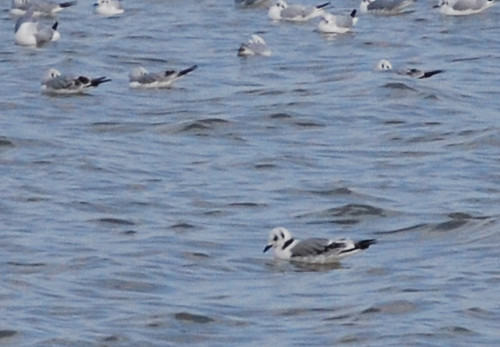
What makes it stick out from the Bonaparte's Gulls in the background is primarily it's black collar, but also the larger size and more elongated structure.
The bird made number 366 on my collective life list (I had 366 previously, but since learning that the Trumpeter Swans I've seen in Ohio are not countable, I took them off). The bird is number 323 on my ABA list, number 285 on my Ohio list, number 272 on my year list and 253 for my Ohio year list.
My year lists are at 273 for the ABA area and 254 for the state. Besides the kittiwake, I added Common Redpoll to the state list and Short-eared Owl and Greater White-fronted Goose for both.
Speaking of lists: We have a new Ohio Birding Checklist with ABA-style difficulty codes. The species are divided into 3 groups among the 6 difficulty codes: Easier to See Birds (codes 1 and 2: 205 birds)), Harder to See Birds (codes 3 and 4: 86 birds), and Review List Birds (codes 5 and 6:123). There are 414 bird species in total on the Ohio list. I'm really happy with this new checklist. It's a good way to measure how good of a year I'm having. For example, here's how my year breaks down by each code so far:
Code 1: 135 out of 136 (same for my life state list)
Code 2: 60 out of 69 (68 out of 69: life list)
Code 3: 24 out of 30 (29 out of 30: life list)
Code 4: 24 out of 56 (36 out of 56: life list)
Code 5: 7 out of 20 (11 out of 20: life list)
Code 6: 2 out of 103 (4 out of 103: life list)
One of our members in the Columbus Avids, Dan Sanders, has issued a challenge of sorts for us to try and see every one of the 205 commonly occurring birds in Ohio for 2008. Doesn't sound too hard, but could still be a challenge, as for 2007, I am missing 9 of the 205 common birds.
Another thing that is good about the list is it gives me some birds to concentrate on adding to the state list for next year, such as my two remaining "Easier to See Birds": Marsh Wren and Least Flycatcher. Other birds I don't have but should be able to add from the Harder to See Birds include Ruffed Grouse, Franklin's Gull, Golden Eagle and Cattle Egret. Everything else I am missing will probably have to be as opportunity allows.
Thursday, December 6, 2007
My new binoculars have arrived!
The optics4birding review was dead on about the poor fit for the rainguards - if you prefer a shoulder harness to a neck strap (as I do), you're going to have to be careful not to lose the guards while walking. I may try to attach them with a short chain or something, since I want to keep my lenses protected.
I'll post my birding experiences with them on Monday, as I will be birding all day on Saturday with them.
Wednesday, December 5, 2007
Ordered the Broadwings
I'll post a review of how I like them next week.
Tuesday, December 4, 2007
Binocular upgrade time
So, now I am in the market for the next step up in binoculars. I have narrowed it to three contenders (all 8x42 bins): The Nikon Monarch ATB, The Stokes Talon, and the Stokes Broadwing.
The Nikon Monarch has been in production much longer than the Stokes series (produced by Vortex), and has a reputation of providing optics near the quality of bins 3x the price. It has a pretty good reputation and is very affordable at $290. It does have some drawbacks, as apparently the focus gets fuzzy at the edges of teh field of view and there's a tendency for prismatic effects when viewing high-contrast objects in bright light. Like my current Nikons, it has a rubber rain guard that you can attach to the strap, and hard plastic objective lens caps that you can easily lose (I think I lost my Nikon Action lens caps within two months of buying them).
The Stokes Talon is billed as a great entry-level set of bins, and are the cheapest in price of the three at $200. They have a good reputation as well, but from what I've read, may not perform as well as the Nikons in terms of brightness and flat field. Like the Nikon Monarchs, there is some prismatic effects, and there's some distortion at the edges of the field of view. The rain cap and lens caps are better than the Nikons, in that the lens caps are attached to the bins so you don't lose them immediately.
Now, from my limited research (only internet searches and no actual testing myself), it seems like the Stokes Broadwing offers a pretty attractive set of bins for not a whole lot more than the Nikons, at $350. What I really like about these is that the optics quality seems pretty good for what is still in the lower mid range for decent bins. Optics4birding.com notes that the focus stays sharp pretty much all the way across the field, with minimal distortion of straight lines right at the edges. Also, there is no prismatic effect when viewing high contrast objects in bright light. The eyecup and objective lens covers are similar to the Talon's, although Optics4birding noted that the rain guard cover seemed too loose. Otherwise, they thought the bins offered mid-price range quality at the high end of the low-price range.
I'm leaning pretty heavily to the Broadwing, but as I have said, I have not tried any of these bins out, and I'm not sure I will be able to compare them before I make a purchase.
If anyone reads this blog and has an opinion, feel free to comment.
and definitely check out optics4birding.com!
Monday, December 3, 2007
250, 251! No, wait a minute. It's 250.
Saturday, I went with my friends Brad, Paul and Jeff up to Oak Openings Metropark near Toledo to see the Pine Grosbeaks that have been hanging out there. Paul and I got good looks, Brad got crappy looks and groused about it all day. But I thought there's bird number 250!
But then as we talked about listing through out the day, I realized that I had been basing my count on my eBird totals, which counted the Trumpeter Swans I've seen this year. Now, in Ohio, Trumpeter Swans are not generally accepted by the records committee, since they are an introduced species (Some say reintroduced, but I gather that there is no good data supporting Ohio as part of their former breeding range, but I digress). So really, when I saw the grosbeak (an Ohio life bird, by the way), it was really only bird 249 for the year. Back to where I started on the day!
But I lucked out and hit 250 anyway at the end of the day, when Brad managed to find the Northern Shrike that he'd seen last week at Maumee Bay State Park.
Unfortunately, I wasn't in a position to get any type of good photo of either bird. I did get a couple good photos of Pine Siskins when we were at Oak Openings, though, so here they are:

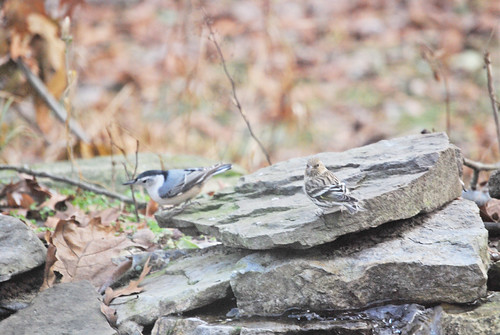
Wednesday, November 28, 2007
Well, I did it.
So, here I am, new ABA member (with an ABA list of 323)!
Monday, November 26, 2007
#366: Ash-Throated Flycatcher
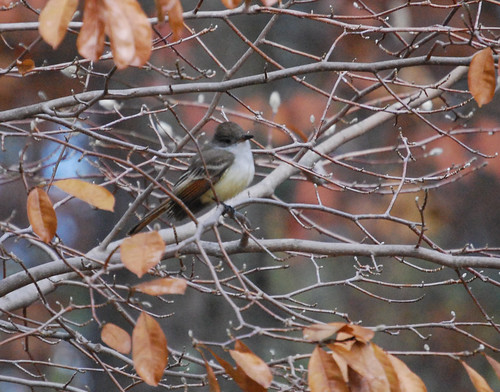 Ash-throated Flycatcher, pretty as can be on November day in northern Massachusetts
Ash-throated Flycatcher, pretty as can be on November day in northern Massachusetts The bird seemed to want to show off how well its plumage matched that of the magnolia tree it was using as home base.
The bird seemed to want to show off how well its plumage matched that of the magnolia tree it was using as home base.Next I headed off to Parker River National Wildlife Refuge outside of Newburyport (with a stop along the way at the Joppa Flats Mass Audubon Center to pick up a new harness for my binoculars and to halfway consider buying a new pair of binoculars as well). My target birds were Snow Buntings, Common Redpolls and a Cattle Egret that had been seen regularly at the North Pool Overlook.
I dipped on the egret, but did get to see the redpolls (year bird number 267). I also added Red-throated Loons (#268) and Snow Buntings (#269) to the year list. I had also thought that the flock of 90 Sanderlings would make the list, but I had forgotten the pair I had seen in Norfolk, VA, earlier this year (missed them in Ohio - rats!). In with the Sanderlings was one different peep - can you identify it in the picture below (for a larger version, go here: http://www.flickr.com/photo_zoom.gne?id=2065972173&size=o)
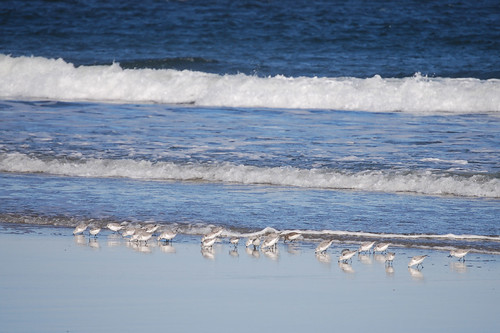
Wednesday, November 21, 2007
Hitting Massachusetts for Turkey
My original plan was to go birding at Parker River NWR (aka Plum Island), but I'm going to hit the flycatcher location first, then head out to Parker River on either Friday or Saturday morning.
I hope to add Cattle Egret and Common Redpoll to my year list there, both species are being seen on the reserve. I might luck into some other birds I need for the year, but otherwise the goal is just to enjoy birding in one of my favorite locations (it's where I proposed to my wife).
So, it could be I will be giving thanks for a new life bird!
Monday, November 19, 2007
One to go
A couple friends and I went exploring the NW part of the state yesterday, with some pretty good finds. Our first stop was the recently decommissioned gravel pit operation outside of New Hampshire along US 33 in Auglaize County, where someone reported Cackling and Ross’s Geese in with Canada and Snow Geese. We found the flock on one of the ponds, but it got up before we could sort through them and landed in a nearby field. Fortunately, this probably afforded us even better looks at the birds. We weren’t able to pick out any Cackling Geese from the
We finished the day at
So, 250 looks to be a lock, but I'm not going to count any birds before I see them!
Monday, November 12, 2007
Three birds down, five to go
The weather and light quality was crappy all day. We started out in Geauga County at a home where Evening Grosbeaks have been visiting, and sure enough, a group of four females dropped in for our enjoyment (and for their place on my Ohio life list).

Next we hit West Woods park nearby, where I added Pine Siskin to the year list and my Ohio life list. Two state birds in one day, not bad!
We then trekked up to the lake, where we were confronted by a mysterious lack of Red-breasted Mergansers. I doubt we saw more than a couple hundred maximum, and that's being generous. Normally we see thousands of mergs on Lake Erie in late November, but not today.
A stop at Simms Park in Euclid nabbed us a pair of Black Scoters, which were the last year birds I had for that day. I just missed Snow Bunting at Headlands Beach SP, which would have been number four.
So, I now stand at 245 species for the year in Ohio. Will I make 250? Stay tuned and find out!
Thursday, November 8, 2007
Update to the last post
Evening Grosbeak
Snow Bunting
Pine Siskin
Purple Finch
Brant (29 seen on the lake today)
Black Scoter
Short-eared Owl
Northern Shrike
That's eight. If all goes right on Saturday, I could pick up 6 of those birds.
Wednesday, November 7, 2007
Eight birds away
I thought I might expand on that and list some of the birds that I still need for my year list AND still have a halfway decent chance of adding, ahead of my Columbus Avids trip this Saturday.
The list includes, in no particular order:
Purple Finch
Pine Siskin
Greater White-fronted Goose
Cackling Goose
Northern Shrike
Black Scoter
Merlin
Iceland Gull
Short-eared Owl
Snow Bunting
Lapland Longspur
Snowy Owl
Of the above, Pine Siskin would be an addition to my Ohio life list.
There are also some less likely birds I could get, which include:
Brant
Harlequin Duck
Northern Saw-whet Owl
Red Crossbill
Common Redpoll
Little Gull
Pomarine Jaegar
Parasitic Jaegar
Golden Eagle
Black-legged Kittiwake
Purple Sandpiper
Sanderling (maybe some late birds???)
Of these birds, Harlequin Duck, Little Gull, Pomarine Jaegar and Black-legged Kittiwake would be life birds, and Red Crossbill, Common Redpoll and Golden Eagle would be Ohio lifers.
Of the above lists, the species I think I have the best chances of adding are:
Short-eared Owl
Purple Finch
Snow Bunting
Northern Shrike
Pine Siskin
Greater White-Fronted Goose
Black Scoter
That's seven. So basically, I need to get LUCKY!
Monday, November 5, 2007
Finch finding fails
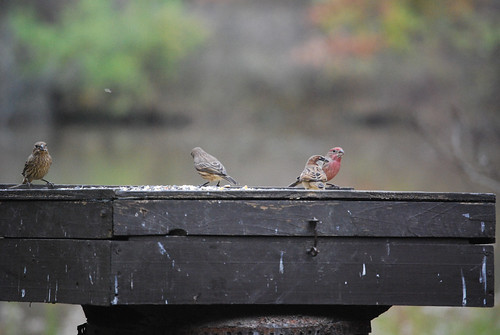
To add insult to injury, reports from Blendon Woods today included a Merlin and Pine Siskins, both of which would make great additions to my year list, especially for Ohio (I am EIGHT birds away from 250 species in Ohio for the year- my best year yet for the state).
However, not all was bad - I did get some nice photographs, especially of a male Northern Cardinal, along with some others.
Friday, November 2, 2007
Gonna try for Purple Finch and Pine Siskin this weekend
Monday, October 15, 2007
LeConte's Sparrows

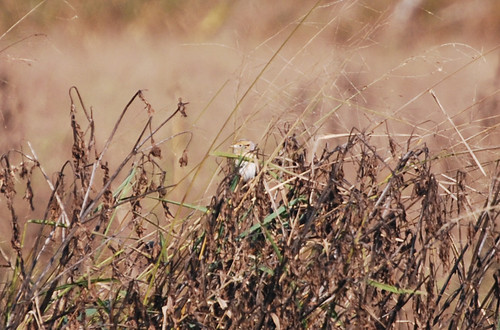
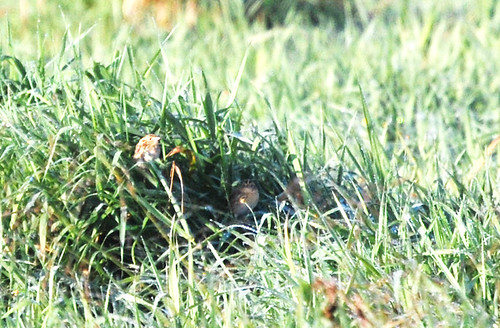

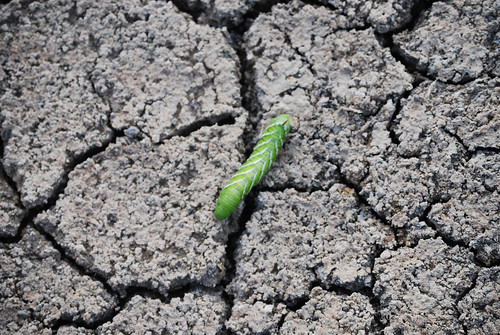
Monday, October 8, 2007
Considering joining the ABA
1. Price: while $45 a year doesn't seem like much, I'm already shelling out big bucks for my professional memberships as well, not to mention my dues to Audubon and the Ohio Ornithological Society.
2. The ABA area - For some reason, the ABA doesn't include any Mexican territory within its area, but does include Canada. The Birdfreak blog post for may 22, 2007 addressed this better than I could, so I'll link to it: http://birdfreak.com/should-mexico-be-part-of-the-aba/#comment-2260
However, one issue that Birdfreak didn't raise that seems glaring to me is that the ABA includes Canada. Why exclude one country but not another? To be frank, in today's political climate, it has a subtle reek of racism. I'm sure (or at least I hope) that's not the case, but still, the benefits to including Mexico seem self-evident, and I don't see any reason to not include it that wouldn't also apply to removing Canada from the ABA area. Unless the ABA just wants to serve the needs of big listers, which seems pretty lame to me, but if that's the case, then they SHOULD remove Canada from the region and make the area only the land and territorial waters of the 49 continental states.
Anyway, I'm mulling it over.
#365: Orange-crowned Warbler
The focus of the trip was sparrows, though. Our first stop was the former site of the Richfield Coliseum, once home to professional sports and U2 concerts but now a grassy field. Apparently in wetter years, it's a great spot for Ammodramus sparrows like Nelson's Short-tailed and Leconte's, but the only sparrows we scared up there were Savannah and Song, although Palm Warblers were a nice consolation.
Our next stop was Dike 14 at the Cleveland Waterfront State Park, or rather, the fenceline since you aren't allowed into this important bird area. This is where I saw the Orange-crowned Warbler, along with Lincoln's, Savannah, White-Crowned, Chipping and Song Sparrows and Dark-eyed Juncos. Other species of note included Red-breasted Nuthatches, Pine Warblers, Blue-headed Vireo, Eastern Phoebe and Yellow-bellied Sapsucker (one of which was apparently harvesting something from a metal radio tower).
Next was Lorain Harbor, where a new impoundment has been freshly constructed. They helpfully bulldozed a coupel trails through the phragmites, and the place was hopping with sparrows. We had Song, White-crowned, White-throated, Savannah, Swamp, and two Nelson's Sharp-tailed sparrows, along with Common Yellowthroat.
Finally, we cruised the Cedar Point Chausee, but high traffic volume discouraged us from walking out to scope birds. Our drive by did not reveal anything that looked too interesting, so that was fine.
On sunday, I tried for the Franklin's Gulls at Buck Creek State Park and Indian Lake, but dipped on both. I guess that gull will have to wait a while for me.
Friday, October 5, 2007
Conneaut: I can see the potential
Still, I bet when a migration wave hits it, it's awesome.
Friday, September 28, 2007
Sabine's Gull stopover
I am going to make my first trip to Conneaut next week, though. I have to be in Ashtabula on business, and it makes no sense to at least stop and check it out! Conneaut is practically in Pennsylvania and is about 3 or 4 hours from Columbus, so I've never gone up. Don't know what I will see, but it's a good spot for migrating shorebirds and a likely spot for odd gulls to show up.
Our next Avids trip is next weekend, but the forecast is for rain. I really hope it changes, as I haven't been out birding in a while. I didn't get the chance at all in Massachusetts (I'll be back out for Thanksgiving and I really want to make the effort to get out and do some birding one morning, though).
I also started to get some participants together for the birding trip I am leading to Sault Ste. Marie in January. So far, I have almost 8 people, which will fill up the trip. Should be a good time!
Thursday, September 20, 2007
Out in Massachusetts this weekend
There's a Green-breasted Mango in Beloit, Wisconsin right now, after all: http://bwfov.typepad.com/birders_world_field_of_vi/
Monday, September 17, 2007
Blah day for birding
I went to Hoover first to try and get a couple more shorebird species on my year list, specifically Sanderling and White-rumped Sandpiper. No such luck. Hoover was practically devoid of shorebirds, and not counting Killdeer, I maybe saw 15 individual shorebirds, the best species being Semipalmated Plover. I did have a nice look at a soaring Bald Eagle, and there were hundreds of swallows flying all over. But still, the lack of shorebirds was disappointing. One spot that had Sanderling and WRSA a couple days ago did not have a single bird.
I then went to Blendon Woods, hoping to pick up some warblers near the Nature Center (the common warbler I am missing from the year list is Tennessee, so that was my goal) but didn't have a single warbler. The screaming children on the nature trail probably had something to do with that.
Days like that can be really discouraging. Perhaps I'll see something cool when I am in Massachusetts this weekend, but that would have to be something practically falling in my lap, as there will be no time for birding.
Monday, September 10, 2007
Avids trip, Sept 8 2007 - Godwits and more



Tuesday, September 4, 2007
#364: Red Phalarope
I have an Avids bird trip this weekend I am really looking forward to. It's been pretty exciting the last week or so in Ohio birding, with the confirmation of breeding Mississippi Kites and interesting shorebirds and waders showing up, including a juvenile White Ibis and Reeve at locations in the state.
Thursday, August 16, 2007
Hoover Reservoir mudflats
Wednesday, August 15, 2007
Little Blue Heron
I am missing my next Avids trip, which is sort of frustrating in that they are going to Conneaut, where I have never been, and which is a birding hotspot for shorebirds. I am going to a party in Dayton instead. I plan on birding Hoover again that morning to sort of make up for it.
I need to contact some folks in the UP birding community next month to start planning the Winter Birding in the Eastern UP trip I'm leading for the Avids this January. As I think I have mentioned previously, I've never actually birded the eastern UP, so I'll need some advice.
Picks from Hoover yesterday might be up later.
Monday, August 13, 2007
Slow birding lately
I'm missing my monthly Avids trip next Saturday as we are going to my cousin's "Murder Mystery Dinner Party" and although it's in the evening, the Avids' destination is too far away for me to make it back to Columbus and then to Dayton in time. Oh well.
I may try and make it out one of these afternoons, but one of the things I am finding about being married is that I have to take into account the needs of my wife when planning these things, since we are a one-car family. I can't just hop into the car and spend a couple hours birding after work like I used to. Hence, my birding blog may go through periods of inactivity as I may not have as much time to bird as I used to.
Tuesday, July 31, 2007
#363: Lark Sparrow in an unusual location
The birds were reported to be hanging out in a scrubby area near a Lowe's hardware store in south Columbus, near a seasonal wetland. I heard one singing, and caught a glimpse of a juvenile bird skulking about in some weeds. It's possible they bred here, but they could also be early migrants. In any case, Lark Sparrows in Columbus is almost unheard of.
The day after I saw them, some other folks went there and saw one bird, but then confirmed breeding Blue Grosbeaks, which is also unheard of for Columbus. So the moral is: check those vacant lots!
Monday, July 23, 2007
Answer to the last blog post title: Do Both!
I arrived at the Brass Circle golf course about 10:30 am and parked at the end of the course. About 10:40 AM, I observed one kite being harassed by two smaller (unidentified) birds, before it ducked down below the tree line. I saw it (or the other one, there's two and they are almost certainly breeding) again a few minutes later. And voila, that's number 362 on my life list and number 277 on my Ohio list.
Satisfied, I headed back up to Columbus, listening to my favorite radio show "Wait, Wait, Don't Tell Me - The NPR News Quiz" which is one of the funniest news commentary shows in all of media.
I went up to Sharon Woods Metro Park, which is in one of my atlas blocks. Although breeding season is coming to an end, there were still a lot of birds with recently fledged young - some that were so close to adult plumage that behavior was the main indication of a juvenile instead of an adult. I added the following confirmations for block 58D2NW: Blue-Gray Gnatcatcher, Cedar Waxwing, Eastern Kingbird, Brown-headed Cowbird, Blue Jay, Tufted Titmouse, Northern Mockingbird. I also updated Common Yellowthroat to a T7 code. This will probably be my last set of OBBA observations for this season, as household duties will keep me out of the field for the next couple of weeks.
But then it's shorebird season!
Wednesday, July 18, 2007
Life bird or breeding bird survey? That is the question
However, I also should put in some time for the breeding bird atlas, as I have 3 blocks I have signed up for and it's near the end of the season. What to do?
Also on Saturday, my wife E. B. is cooking pancakes for breakfast. That sort of rules out the survey option. I think I will go for one of the potential life birds, then maybe get up early Sunday morning and do some work in my newest survey block.
The thing about my new survey block, is that I didn't realize how urban and blighted it is when I signed up for it. I asked for it because it is a "priority block" - that is, it's a block that was surveyed during the first atlas in the 1980s and they want all priority blocks surveyed to ensure comparative data. The list of birds from the 80s survey seems amazingly diverse for how the area looks now - mainly neighborhoods of closely packed houses of low-income families. One park has a decent woodlot, but I am pretty unsure of the safety of bushwacking through these woods by myself in this location. There is also a public golf course, and next season I will ask permission to survey on its property. American Kestrel and Wood duck were confirmed breeders in the 80s in this block, and if they are going to be present now, that's probably where they will be.
Thursday, July 12, 2007
Thoughts on Maine birding
I think the first thing I noticed was the regional difference in the songs of Song Sparrows. I was awoken on the first morning on the island by one outside the window of our cottage, about 4:30 am. At first, I had no idea what it was, but after listening for a while, I thought that while the pattern wasn't the same as Midwestern sparrows, the timbre of the song was pretty much the same. Later, I saw a Song Sparrow singing this song, which clinched it.
Another thing was of course all the breeding warblers, especially the Black-throated Green Warblers which seemed to be everywhere. Northern Parulas and Ovenbirds were also pretty common, as well as Yellow Warblers.
What wasn't very diverse were ducks and raptors. I had two species of each: Common Eider and Mallard for ducks, Osprey and Bald Eagle for raptors. I saw no hawks of any sort while on the island, not even a Red-tailed Hawk.
It was also interesting to not have Ring-billed gulls around. I'm used to the Great Lakes, where they are the most common gull. Instead, Herring Gulls and Great Black Backed gulls were the norm.
Sparrows, besides the Song Sparrows, included Eastern Towhee, Dark-eyed Junco and White-throated Sparrow.
All in all, it was pretty good birding, with 70 species for the whole trip, including the seabirds I posted about earlier.
Wednesday, July 11, 2007
Monday, July 9, 2007
Back again - brief post
This will be a brief update on my birding in Maine, with pictures to come soon.
The best birding was the whale watching trip, which nabbed me 8 life birds - Atlantic Puffin, Razorbill, Common Murre, Arctic Tern, Greater Shearwater, Sooty Shearwater, Wilson's Storm-petrel, and Northern Fulmar. I also added Black Guillemot to my list the day before the whale watching trip, for a total of nine life birds (bringing my life list up to 361). We also saw finback and humpback whales and harbor seals.
The land birding was also good, although I only got about 2 hours of serious, stand-alone birding on Mount Desert Isle. The rest of my birding was done on an"as-encountered" basis. I notched up 70 species in 5 days of casual observation, which isn't bad.
More later when I get my photos online.
Thursday, June 14, 2007
Going away for a couple weeks
But I should have some good bird stories when I get back!
Tuesday, June 12, 2007
Atlasing in Sharon Woods
Sharon Woods is a mix of habitats, including somewhat mature woods, streamside habitat, open fields, a lake, and lawns with trees scattered here and there. I should be able to get a great deal of confirmed breeders here in the next couple of breeding seasons. I will be missing out on the rest of June due to my marriage in two weeks - I leave for Massachusetts on Friday and won't be back until July. Hopefully some other folks who bird there will also add observations while I am gone.
Blockbusting weekend in SE Ohio
I was teamed with John Habig, a birder I had not met before but recognized from his posts to the Ohio Birds email list. We surveyed six blocks in 15 hours of birding over two days. We confirmed breeding for 22 species of birds out of 76 observed, including interesting birds like Blue-winged Warbler, Ovenbird, and Orchard Oriole. Our two highlights were a territorial White-throated Sparrow and a territorial Black-and-white Warbler.
The absolute highlight for the group, however, was a find of four Yellow-crowned Night Herons at a farm pond in Gallia county. There are only two other records in the atlas of this species and only one of those is a confirmation (strangely, it seems that the breeding colony in Columbus has not yet been entered into the atlas website application, so that's a total of two confirmed breeding locations). Hopefully, someone will be able to go back a little later and see some fledged young.
I highly recommend participating in breeding bird surveys - it's as fun as birding during migration, and maybe even more of a challenge.
Monday, May 28, 2007
To count or not to count
I also added Yellow-billed Cuckoo to my year list. Otherwise, numbers and varieties of birds were pretty low that day. I managed to get a few decent photos, though, which was one of my goals for the day. Here's a few (in order: female Canada Warbler, Great Egret, female Black-and-white Warbler, Ruddy Turnstone, Barn Swallow):
